User Area
Software Release History - Version 23
Version
23.0
New Facilities and Improvements
in LUSAS Version 23.0
V23.0-1 was made available for general download on
28 November 2025
This is a major
release of new facilitites, enhancements and change requests
V23.0-0 was made available for general download on
24 October 2025
This is a major
release of new facilitites, enhancements and change requests
In summary....
|
General
interest
Loading
Design
codes
Tank
design
|
Geotechnical
Customisation
and scripting
Other
Supporting
material
|
In detail...
Pushover
analysis
For
a pushover analysis the new pushover
curve facility will extract the pushover curve from
which the ‘performance point’ or ‘target displacement’ can be
derived for a supported Code of Practice.
Related
new facilities are provided for defining plastic
hinges, plotting contours of hinge status for
Immediate Occupancy, Life Safety and Collapse Prevention categories,
and for inspecting force-deformation curves for
specific hinges.
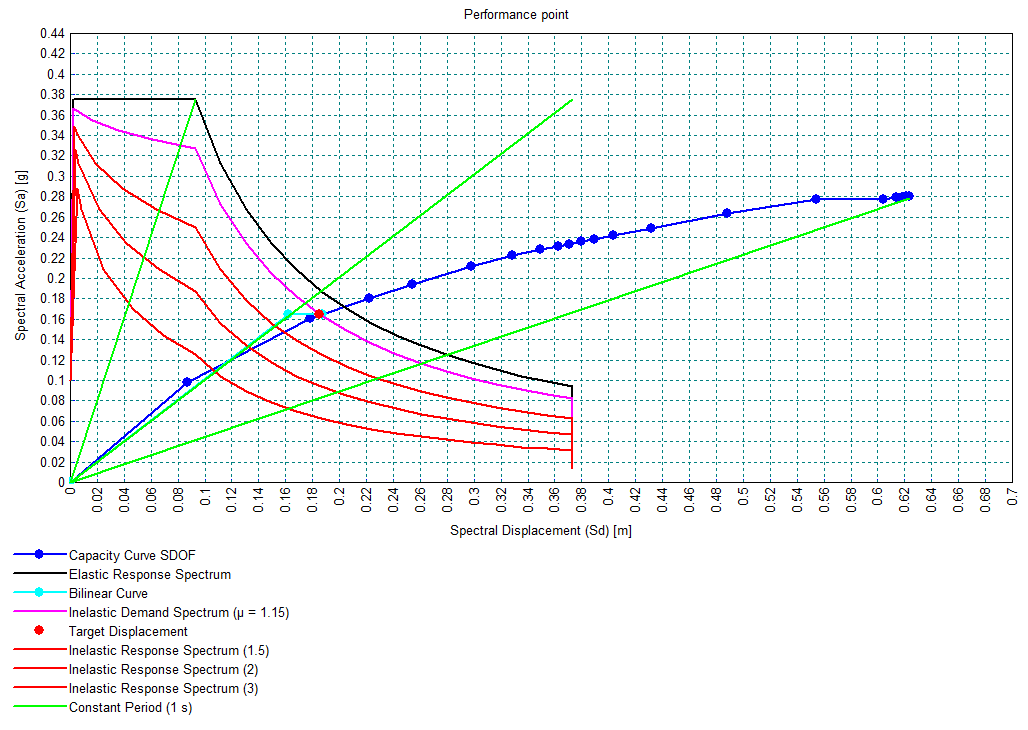
Plastic
Hinges
The
existing range of interacting and non-interacting hinges has been
enhanced for use in pushover analysis. Any number of points can be
used to define force-deformation curves. Automatic force-displacement
definitions have been included for steel sections. For other materials
(e.g. concrete sections), moment-rotations may be computed and
introduced manually as absolute values.
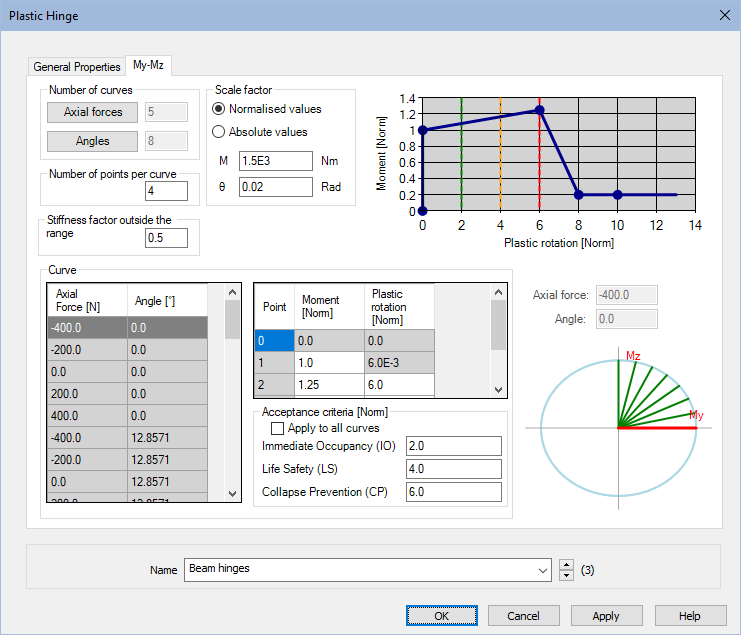
Plot
contours of plastic hinge status
Plot
contours and values of plastic hinge status for Immediate Occupancy,
Life Safety and Collapse Prevention categories.

Inspect
Hinges
The
inspect hinges tool allows you to view he definition of hinges and
create new hinge materials by editing existing ones. It shows the
actual (absolute values) of the force-deformation curves. If results
are available, the response of a specific hinge for a chosen analysis
and loadcase can also be inspected.

Fibre
multi-crack concrete model
A
Fibre Multi-Crack Concrete material model is now supported. This
is a plastic-damage-contact model in which damage planes form
according to a principal stress criterion and then develop as
embedded rough contact planes.
The
model can be combined with the creep and shrinkage behaviour
appropriate to any of the supported Codes of Practice, resulting
in a comprehensive time-dependent behaviour including cracking
and crushing.
|
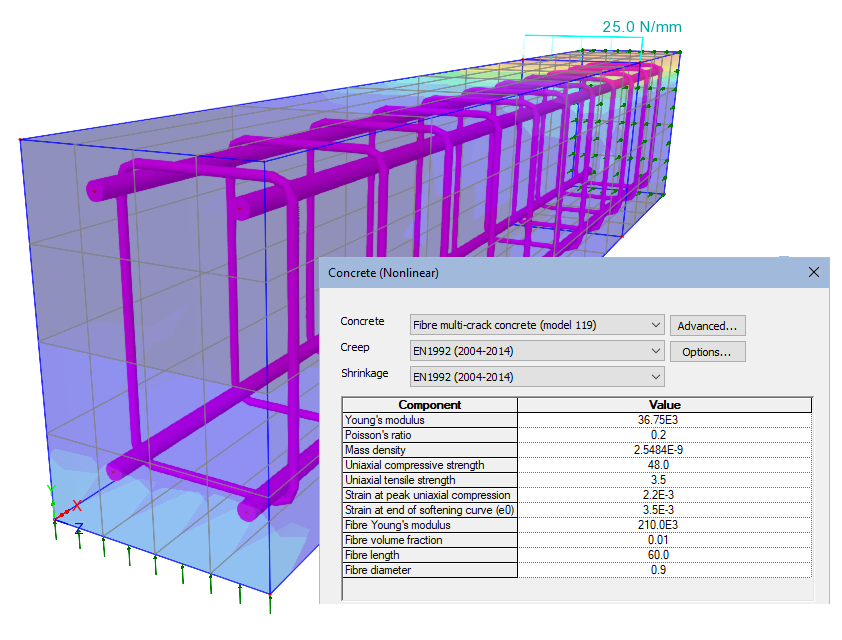
|
Direct
export to MS Excel
Calculated
results may now be exported directly to a Microsoft Excel
spreadsheet .xlsx file rather than having to be viewed within
the Print Results Wizard first. This can be done in three ways:
-
From
the Print Results Wizard dialog by checking the 'Save to
file' checkbox.
-
By
right clicking on a ‘Print Results Wizard’ attribute
within the Utilities  treeview
and selecting the context menu item 'Save To Excel File'. treeview
and selecting the context menu item 'Save To Excel File'.
-
If
using the LUSAS Programmable Interface, call the LPI
function saveToFile, and provide an optional argument for
the location and filename.
|

|
Reinforcement
attributes and zones in surfaces
Reinforcement
in the top and bottom of a slab or in the faces of a wall is now
termed 'surface reinforcement' in LUSAS and is stored as an attribute
within the Attributes treeview. Bar reinforcement size, spacing, cover
and skew angle of bars can be defined according to project
requirements. Cartesian and radial reinforcement arrangements are
supported as well as the ability to define extents over which a
defined reinforcement layout applies.
 |
 |
| Single
reinforcement layout |
Multiple
reinforcement layouts and zones |
The reinforcement
attributes created are subsequently assigned to each surface
representing a slab or wall for which the reinforcement layout is
applicable. RC slab/wall design attributes need also to be assigned to
the appropriate surfaces representing concrete slabs and walls to
allow RC Slab/Wall Design calculations to be carried out.
Visualisation of x and y reinforcement directions is now provided.
The extents of any defined reinforcement zones may be visualised by accessing the properties dialog of the contour layer and choosing to plot results for 'Reinforcement (model)'. Each selected reinforcement layout assignment / zone will be displayed in a unique colour alongside an associated contour key.
Mixed
material modelling
For
arbitrary sections, where section properties are dependent on the
modular ratios of component materials, these now have the option to be
calculated at tabulation time using the material an Arbitrary Section
Material attribute assigned along with the geometric attribute. The
use of several Arbitrary Section Material Attributes means the section
properties can be updated to reflect in-construction and in-service
conditions, avoiding the need to define multiple arbitrary sections or
re-run the arbitrary section property calculator for each material
combination.
Infill/Encased
sections now use the compound material from the assignment for each
element and in each loadcase rather than be specified in the geometric
attribute. This is now consistent with Bridge Deck (Grillage)
material. Different material properties may be assigned in different
analyses and loadcases as required to model staged construction
processes.
Improved
visualisation of loading
Loading
can be visualised by its effect on the model or by definition,
allowing you to see exactly how the loading is applied. This is
particularly useful with discrete loads showing clearly where loading
intersects a search area and where loading that misses the search area
will not load the model.
Loading
values are now displayed alongside loading arrows, but overlapping
labels are suppressed to ensure that the highest magnitude is always
legible values visible. In situations where overlapping occurs, higher
results values take priority over lower ones and larger negative
values take priority over lesser ones. Labels that overlap are made
transparent, suppressing the associated arrows, providing clearer
displays. Zooming in to enlarge the view of a model will progressively
make previously overlapping arrows and load values fully visible.
Labelling
of loading with magnitude and units makes it easier to check the
loading assigned and to distinguish between force and pressure.
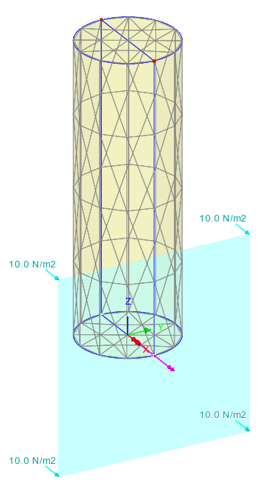 |

|
 |
| Visualised
by definition |
Visualised by
effect on model |
Visualised
by effect on mesh
(uses different loading) |
Vehicle
Load Optimisation now supports EN1991-2 LM2 loading
Group
1b is now available on the Vehicle Load Optimisation Optional Code
Settings dialog for Load Model 2. This is for local verifications
("short structural members" to EN1991-2 clause 4.3.1(2)(b)).
ψ and beta adjustment factors can be modified using the Advanced
options button.
Specify
initial element temperatures in a thermal analysis
Initial
temperature loading conditions can now be specified for a thermal
analysis in a manner that is consistent with a hygro-thermal analysis.
Concrete
creep and shrinkage to NZS 3101
Design
code 'NZS 3101:2006 – New Zealand Standard – Concrete Structures
Standard' is now supported.
Time
dependent tendon losses for NZS 3101
Tendon
loss calculations (friction, anchorage set) and post-installations
losses (elastic shortening, creep and shrinkage of concrete and
relaxation of tendon steel) based on time inputs and calculated
stresses are now supported for NZS 3101.
LUSAS
Tank Updates
-
A
'Concrete (Membrane)' tank option is now available in the concrete
tank definition dialog for structural and
seismic modelling and assessment. This tank type assumes the
liquid is retained by a membrane that transfers all loads
directly to the outer concrete wall, with no structural
independence of the inner layer.
-
Horizontal
beam stick models now support the
distribution of liquid masses following the guidelines of
ASCE 4-16:2017.
-
Vertical
beam stick models have been revised to
clearly define masses of different components instead of
lumping all the masses at each level. The inner tank (when
present), the flexible liquid mass, and the rigid liquid
mass are now independently modelled and connected to the
main structure through a horizontal rigid beam, while
horizontal displacements are restricted.
-
The
'Add Seismic Loading' dialog has been updated to support
concrete membrane tank types. The liquid induced moments are
now optionally automatically calculated, along with the
heights of lumped liquid masses (impulsive and convective).
-
For
all types of tank definition, a context menu option 'Show
Properties' is now available. This allows for easy
inspection of useful tank information such as average
dimensions, cross sectional areas, volumes, total structural
and non-structural masses, total insulation thicknesses and
seismic design natural periods, stiffnesses and dimensions.
See
LUSAS Tank for
more details about this software product.
|
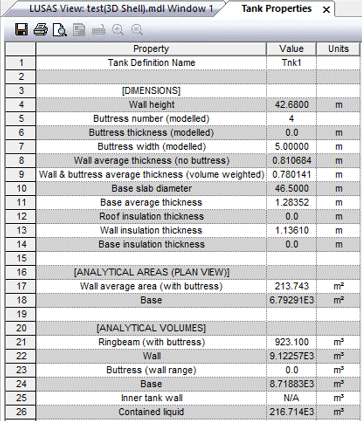
|
Hardening
soil model
The
hardening soil model with small strain is a multi-surface plasticity
model based on the well-known Duncan-Chang hyperbolic model. The
hardening soil model is capable of modelling a variety of granular and
cohesive soils. Its parameters are obtained directly from standard
triaxial and oedometer laboratory tests. An overview example is
provided with this release. See the Geotechnical
Analysis option for details of all models supported.

Barcelona
Basic Model
The
Barcelona Basic Model is a constitutive model for unsaturated soils
which reduces to the Modified Cam Clay model at zero suction. The key
feature of the model is a load collapse curve, which allows an
increase in yield stress (apparent pre-consolidation stress) with
suction and introduces the possibility of expansion or collapse upon
wetting depending on the current pressure. See the Geotechnical
Analysis option for details of all models supported.
Smart
LPI text editor with Intellisense and improved help
Links
are provided during the LUSAS installation process to optionally
install VSCode - the LUSAS recommended editor for LPI script
files. If not installed during installation, selecting the menu item File
> Script > LPI Editor from within
Modeller, or by using the LPI editor toolbar button  will
initially take you to a download page and then, after installation,
will subsequently launch VSCode as the LPI editor. will
initially take you to a download page and then, after installation,
will subsequently launch VSCode as the LPI editor.
VSCode
includes a debugger and language servers capable of providing
'IntelliSense' (a code completion tool that provides a range of
features to assist users in finding the correct LUSAS function and
understand its arguments) and a huge library of extension modules.
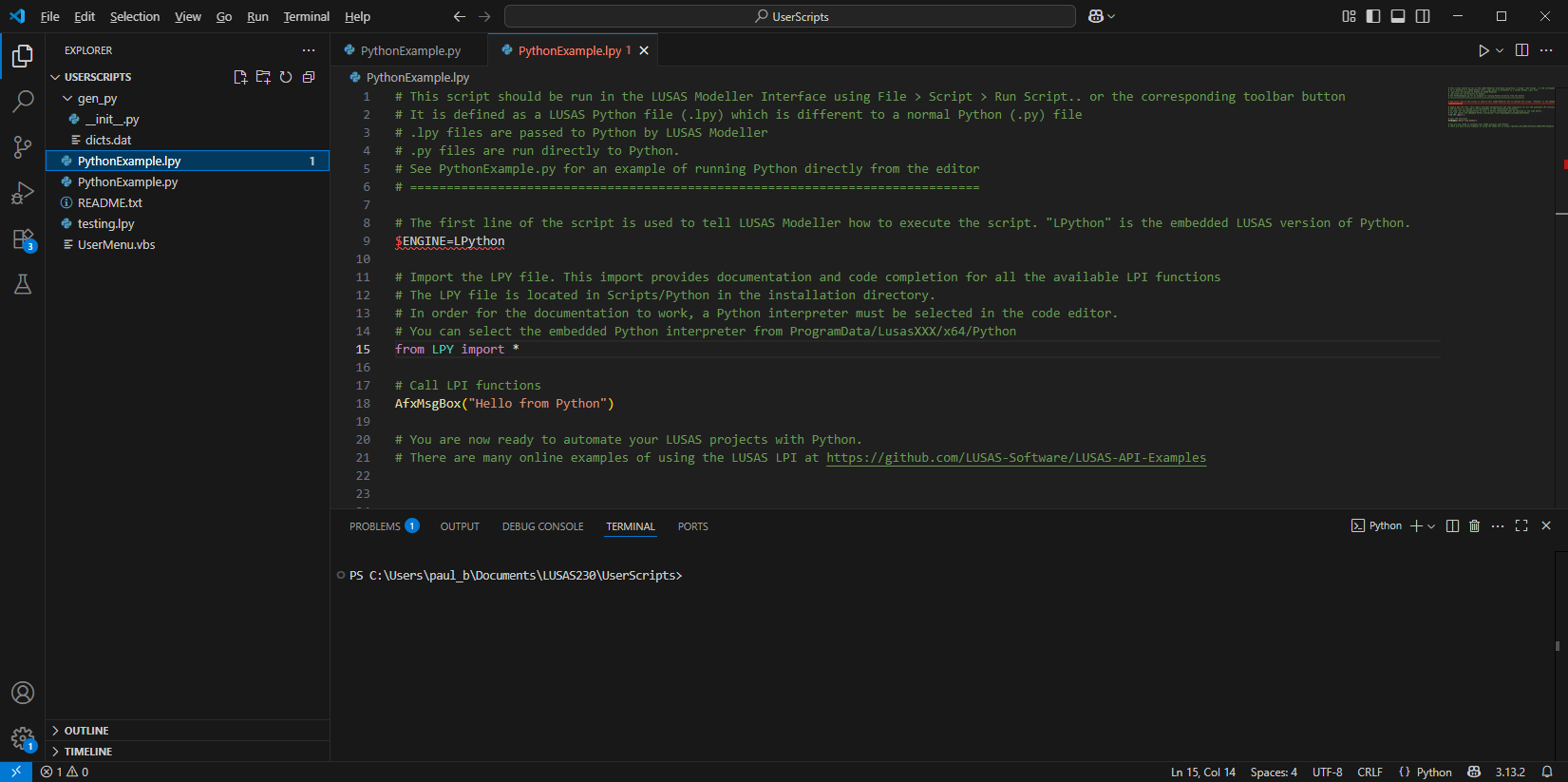
LUSAS
GitHub repository
Introduced
between the releases of V22.0 and V23.0, the LUSAS GitHub
repository provides practical examples of using the LUSAS
Programming Interface (LPI) in Python, VBScript, Jupyter, C#,
VB.Net and Grasshopper.
The
repository provides engineers with a centralised,
well-documented set of automation examples using the LUSAS
Programming Interface (LPI) and encourages the use of LUSAS in
digital workflows (e.g., BIM, Python-based engineering,
AI-assisted design) by lowering the learning curve.
See
the LUSAS
GitHub repository for more details. |

|
Python
now supplied as part of a LUSAS installation
|
An
embedded Python interpreter is now provided as part of the LUSAS
installation.
It
can be used to run Python scripts from LUSAS and, when 'Python'
is selected as the script language in the LUSAS
configuration utility it will be used to
generate session files and display LPI commands in the Python
language.
See
LUSAS
Programmable Interface (LPI) Scripts for more information
|

|
New
Grasshopper plugin components
Point,
Activate/deactivate, Volume member, Volume mesh, Loadcase, and
Re-order loadcase components have been introduced into the LUSAS
plugin for Grasshopper since the release of V22.0 and V23.0
See LUSAS
plugin for Grasshopper on the 'food4rhino'
website for more information.
Specify
behaviour of variations outside evaluation limits
For
general field, surface function and profile variations it is now
possible to specify the behaviour of a variation outside of its
defined limits.
Documentation
User
manuals
-
Relevant
documentation has been updated for this new release.
-
Selected
manuals are provided in PDF format as part of the LUSAS
installation and are also available for download from the User
Area of the LUSAS website.
Worked
Examples
Worked
step-by-step examples and Overview examples (in PDF format) and
associated files referenced by those examples are available for
download from the User Area of the LUSAS website.
|